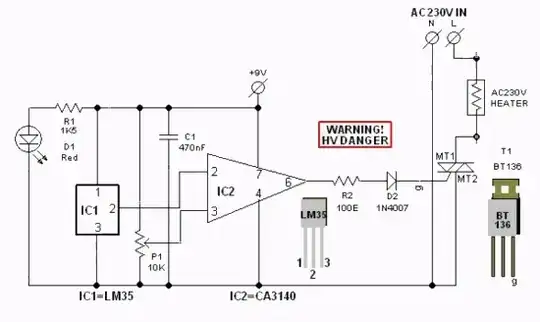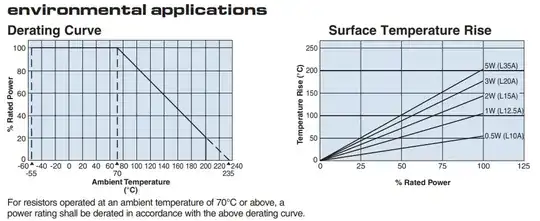The subject seems to be very easy and simple but performing research and looking at the real devices I get more and more questions.
Let's take this article as a basis. It has the following circuit:
explained in the article. The problem I get is related to the "heater" in the circuit. And, what's not that funny, with resistance in general.
If we look into the resistor datasheets it seems rare one states the operating temperature for the resistor. Second, it shows the "derating curve":
where we may guess what operating temperature is assumed to be, but showing the plain resistance value for temps below 70 C. It is clear is it not actual resistance curve, but kind of misleading. Edit: and I made a mistake thinking that it is resistance derating, but it is power derating.
The device I am going to prototype will consist of several identical 2 Watt resistors in series. I have similar available device on hand, my calculations show that power rating of the resistors involved is twice the expected during operation, current flowing through the resistor chain is expected to be 0.05A @ Vrms=155 V, but for some reason the same BT136 is used, and it makes me stuck. The BT136 is 600V/4A device, and seems to be severe overkill for the device utilizing 275VAC (max) with 0.07A current. Is it just a coincidence of someone copy-pasting, or it has some very specific sense I do not see? Using smaller triac will save some board space.
The only viable idea I have is that at -40C (industrial temp) resistor chain resistance may be less than nominal declared in the datasheet and marked on its body, thus startup current will be more than operating one, but I am unable to find related information in the (power) resistor datasheets.
Any advice and insight is appreciated.
Update: Z0109MN seems to be appropriate?
(not related to question: there's a problem with series resistor circuit - if one of resistors starts failing increasing its resistance the power on it may get several times higher than planned, causing more damage, but then will decrease back as resistor keeps opening).

